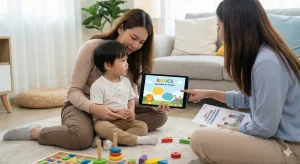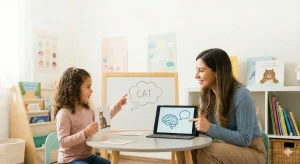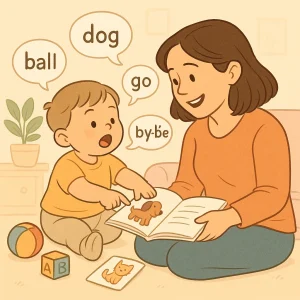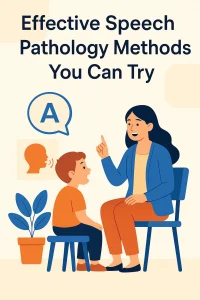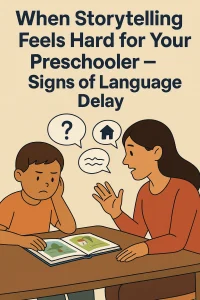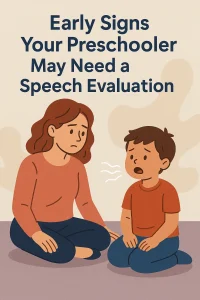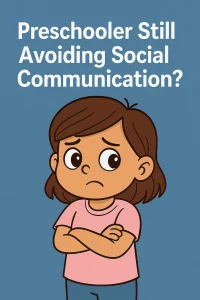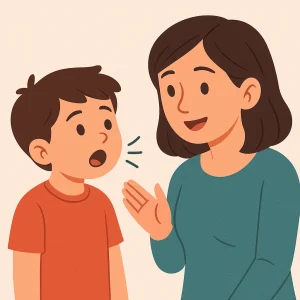10 Fun and Creative Speech Therapy Ideas Kids Will Love
Last Updated: June 24, 2024
Imagine this: it’s speech therapy time, and instead of the usual reluctance, your child is eagerly asking, “What’s next?” As a parent or therapist, you know that when therapy feels like play, kids are more motivated, engaged, and eager to participate. But making speech therapy at home fun can be a challenge—especially if you’re not sure where to start!
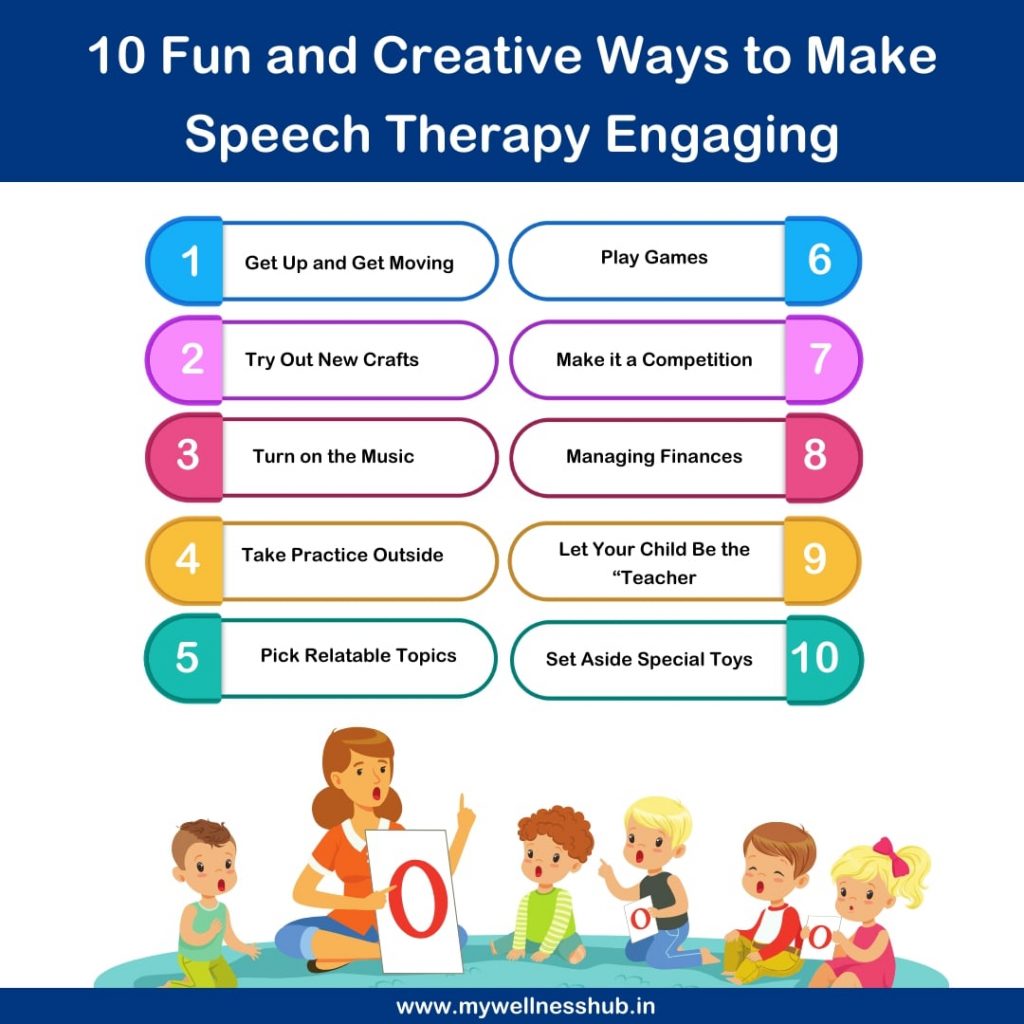
1. Get Up and Get Moving
Adding movement to speech therapy sessions can make learning more exciting and effective. Physical activity boosts energy and helps the brain absorb information better, making speech practice feel like play.
Engage with Movement
Kids learn well when they’re moving. Making speech therapy active and fun can keep your child engaged and happy to participate. This is especially useful for children who struggle with sitting still or repetitive tasks.
Ideas:
- Hide and Seek: Each time your child finds you, have them say a word or sound they’re practicing, like “cat” or “hat.” It’s a playful way to work on speech!
- Scavenger Hunt: Create a list of items to find around the house or yard. Each item can be paired with a word or phrase for your child to say, like “rock” or “I found a rock!”
- Simon Says: Use commands like “Simon says, ‘say apple three times.’” It’s a fun way to combine following directions with speech practice.
- Obstacle Course: Set up a simple course at home. At each station, have your child say a word or sentence, like “I can jump!” before moving to the next part. It’s a mix of movement and speech practice.
- Ball Toss: Toss a ball back and forth, and each time your child catches it, they can say a word or phrase. This can be as simple as repeating “catch me” or “throw it.”
Benefits:
Adding movement to speech therapy offers great benefits:
- Better Learning: Moving around can help kids remember words and sounds more easily, making each session more productive.
- Higher Motivation: Fun, active sessions keep kids interested and willing to join in, making speech therapy something they look forward to.
- Personalized Fun: Tailoring activities to your child’s interests makes each session feel special, helping them progress in a way that’s enjoyable and effective.
Speech Therapy Activities and Benefits
| Activity | Description | Benefits |
|---|---|---|
| Hide and Seek | Incorporate speech tasks during the game – Example: Have your child say a target word before hiding or after being found. | Enhances engagement and physical activity |
| Craft Projects | Make items like paper plate snakes, sock puppets, or Play-Doh creations – Example: Create a snake and practice the “ssss” sound while working on it. | Boosts creativity and targets specific speech sounds |
| Singing Songs | Use songs like “Wheels On The Bus” and “The Itsy Bitsy Spider” – Example: Pause during the song to let your child fill in the blanks. | Improves motor movements and expressive language skills |
| Outdoor Play | Practice speech while walking, playing on swings, or at the playground – Example: Encourage your child to request activities like “More swing!” | Lifts mood and provides dynamic practice sessions |
| Favorite Games | Integrate speech tasks into games like Candyland, puzzles, or word searches. – Example: Before each turn in a game, have your child pronounce a target word. | Keeps practice enjoyable and rewarding |
Also read: How Wellness Hub Makes Online Speech Therapy Fun & Effective
2. Try Out New Crafts
Crafting is a fantastic way to keep your child interested in speech therapy. Hands-on activities make sessions fun and allow for speech practice in a creative, interactive way.
Crafting Fun
Using crafts in speech therapy helps kids focus on their goals while having fun. The sensory and visual elements of crafting can make it easier for children to stay engaged, creating a positive, playful learning environment.
Examples:
- Make a Snake Out of a Paper Plate: This simple craft is great for practicing the “ssss” sound. As your child colors and assembles the snake, encourage them to make a hissing sound, reinforcing pronunciation through playful repetition.
- Create Sock Puppets: Let your child make sock puppets with different personalities. Once finished, you can use them in storytelling sessions where each puppet says specific words or sounds. This is especially useful for practicing clear speech.
- Build with Play-Doh: Play-Doh is versatile and easy to use. You can create objects that relate to sounds your child is working on. For example, make a dog and practice the “d” sound, or a cat for the “k” sound. This reinforces sounds through fun, hands-on learning.
Additional Tip:
Add simple instructions to each craft to improve your child’s listening and comprehension skills. Give clear steps like, “First, roll the Play-Doh into a ball, then flatten it.” This structure not only makes the activity more organized but also supports language skills by practicing listening and following directions.
3. Turn on the Music
Music is a fantastic tool for making speech therapy enjoyable and engaging. Using songs and nursery rhymes allows you to target speech goals in a way that feels like play, not practice.
Musical Therapy
Music naturally grabs children’s attention, making learning feel fun. Singing songs together can help improve your child’s speech and language skills while keeping them entertained. The rhythm and repetition in songs can make speech sounds easier to learn and remember.
Songs to Use:
- “Wheels on the Bus”: This classic song is ideal for repetitive practice. Sing each verse together, then pause to let your child fill in words. For example, sing “The wheels on the bus go…” and let your child say “round and round.” This repetition reinforces vocabulary and speech patterns.
- “The Itsy Bitsy Spider”: With both singing and hand movements, this song is great for improving motor skills along with speech. As you sing, encourage your child to imitate the hand gestures, which helps with coordination and makes the activity more interactive.
Activity:
While singing, pause at key moments to let your child fill in missing words, which aids with word recall and helps them actively participate. Adding gestures and hand movements also boosts motor coordination and expressive language skills.
- Example: While singing “The Itsy Bitsy Spider,” pause before the word “spout” to let your child say it. Use your fingers to mimic the spider climbing up and down, and encourage your child to follow along.
- Another Idea: For “Wheels on the Bus,” create actions for each verse, like making circular hand motions for “round and round” or pretending to open and close doors. This adds an extra level of engagement and makes each session lively.
Read more: Easy Music Play at Home: Fun Activities for Kids
4. Take Practice Outside
Moving speech therapy outside can make sessions feel like an adventure. The fresh air, new surroundings, and freedom to explore add excitement, helping your child stay engaged and enjoy their practice.
Outdoor Activities
Being outside provides countless ways to practice speech in a relaxed, fun setting. Here are some activities to try:
- Walking: Take a walk and describe the things around you. Encourage your child to name objects, colors, and actions they see, like “red car,” “big tree,” or “running dog.” This helps build vocabulary and observation skills.
- Playing on Swings: Use swings as a chance for speech practice. As your child swings, pause occasionally and have them ask to be pushed by saying “swing,” “more swing,” or “push, please.” You can model slightly longer phrases for them, such as “I want to swing more” or “Please push me.”
- At the Playground: Playground equipment can become prompts for speech practice. Ask your child to name the equipment they want to use or describe what they’re doing, like “climbing ladder,” “going down slide,” or “swinging high.” This builds expressive language and gives them more practice with describing actions.
Interactive Tip
Encourage your child to make requests for activities actively. For example, if they want to keep swinging, wait for them to ask. You can model phrases like “More swing, please” and encourage them to repeat. This approach helps them practice forming sentences and making requests clearly.
5. Pick Relatable Topics
Making speech therapy sessions more engaging is easier when you focus on topics your child loves. A child-led approach can boost their motivation, making practice more enjoyable and effective.
Child-Led Approach
Kids are naturally more interested when they’re learning about things they enjoy. By using their favorite topics, you can create speech therapy sessions they look forward to.
- Example: If They Love Dinosaurs: If dinosaurs fascinate your child, incorporate dinosaur-themed words and discussions into speech practice.
- Word Practice: Use words like “Tyrannosaurus,” “dinosaur,” and “fossil.”
- Discussions: Talk about different dinosaurs, their sizes, and what they ate. Ask questions to prompt your child to use these words in sentences, helping them practice naturally.
Reading Tip
Choose books on topics your child loves to make reading time more engaging and interactive.
- Select Books: Find books about dinosaurs, cars, animals, or any other favorite topic.
- Interactive Reading: As you read, pause to discuss pictures or have your child repeat key phrases. This makes reading a fun, interactive way to practice speech sounds.
6. Play Games
Playing games is a fun way to practice speech without it feeling like work. Games create a relaxed environment where your child can practice speech sounds and language skills.
Game Integration
Incorporate speech exercises into games your child enjoys. This keeps them engaged and motivated.
- Candyland: Before each turn, have your child say a word with their target sound, like “sun” or “sock” if they’re practicing the “s” sound.
- Puzzles: As you work on a puzzle, ask your child to name pieces or describe what they see in the picture, helping with vocabulary and pronunciation.
- Word Searches: Create word searches with target words for your child to find and say aloud. This combines reading and pronunciation practice.
Structured Play
Keep games focused on speech goals while making them enjoyable.
- Set Clear Goals: Choose specific sounds or words to practice during the game.
- Offer Rewards: Small rewards or praise can boost motivation. For example, after pronouncing a word correctly, they can earn an extra turn.
- Keep It Fun: Ensure the focus is on enjoyment. If a game feels too challenging, take a break and try again later.
7. Make it a Competition
Adding friendly competition to speech therapy can make sessions more fun and motivating for your child. A little challenge can turn practice into an exciting game, giving your child something to strive for.
Friendly Competition
Turning speech exercises into a competition can make practice feel like play. Kids often enjoy challenges, especially when there’s a reward to look forward to.
- Pick Dessert: Create a game where “the winner gets to pick dessert.” This can motivate your child to participate actively in speech exercises.
- Skip a Chore: Offer a “win and skip a chore” reward. This simple incentive can make your child more eager to engage in practice.
Engagement
Adding competition gives practice a clear purpose. With a goal in mind, your child is more likely to stay focused and excited.
- Example: Set up a points game where each correct pronunciation earns a point. The first to reach a certain number of points gets to choose dessert or skip a chore, making practice both lively and goal-oriented.
- Another Idea: Use a timer to see who can complete the most speech tasks in a set time. The winner could earn extra screen time or a small treat.
8. Use Reward Charts
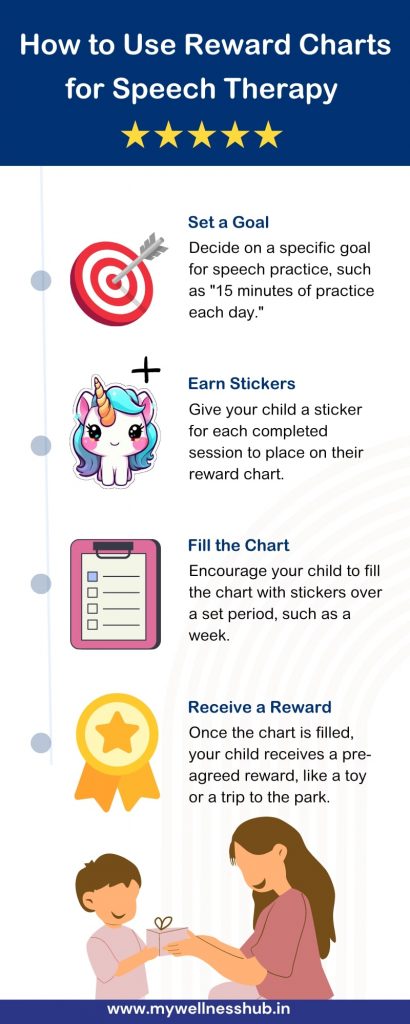
A reward system can keep your child consistently motivated. Reward charts offer a simple, visual way for your child to see their progress and feel rewarded for their efforts.
Incentive Systems
Reward charts are a straightforward and effective tool. With visual rewards, speech therapy sessions become something your child looks forward to.
- Example: Sticker Charts
Sticker charts are easy to set up and fun for kids to use.- Set a Goal: Choose a time or number of speech tasks for each session, like practicing for 15 minutes.
- Earn Stickers: Each time your child completes a session, they earn a sticker for their chart.
- Bigger Rewards: When the chart is filled, reward your child with a bigger prize, like a toy, a park trip, or a special treat.
Rewards
Choosing meaningful rewards keeps your child engaged. Here are some simple incentive ideas:
- Toys: Let your child pick a small toy as a reward to work toward.
- Trips: Plan an outing, like to the zoo, park, or a favorite restaurant.
- Activities: Offer extra screen time, a family game night, or an extra bedtime story.
Reward Chart Example
| Day of the Week | Speech Practice Completed | Sticker Earned | Total Stickers |
|---|---|---|---|
| Monday | Yes | 🌟 | 1 |
| Tuesday | Yes | 🌟 | 2 |
| Wednesday | Yes | 🌟 | 3 |
| Thursday | Yes | 🌟 | 4 |
| Friday | Yes | 🌟 | 5 |
Also Read: How does Reinforcement work in Learning?
9. Let Your Child Be the “Teacher”
Letting your child take on the role of the “teacher” in speech therapy can be a fun and powerful way to boost their learning. When children get to teach, they reinforce their skills and stay more engaged.
Role Reversal
Kids love to switch roles and be the “teacher.” This activity puts them in control, allowing them to quiz you on words and sounds. It’s fun and boosts their confidence!
Activity: Practice Sounds
Here’s an easy way to try this approach:
- Set Up: Explain that they’ll be the teacher for today’s session. Give them a list of words or sounds to quiz you on.
- Quiz Time: Have your child ask you to say different words or sounds. Make some mistakes on purpose!
- Correction: Encourage them to correct you, like if you say “tunder” instead of “thunder.” They can confidently say, “No, it’s ‘thunder!’”
Benefits
- Active Participation: This role makes them more involved and focused.
- Reinforcement: Teaching helps them remember and apply what they’ve learned.
- Confidence Building: Playing the teacher boosts their confidence in their speech skills.
10. Set Aside Special Toys
Making speech practice time exciting can be as simple as setting aside special toys just for these sessions. It makes therapy feel like a treat, and your child will look forward to it.
Designated Speech Toys
Choose toys that your child loves but doesn’t get to play with all the time. These “special” toys make speech practice more appealing and unique.
Examples
- Interactive Toys: Toys like talking dolls or action figures are great for speech practice. Your child can use them to practice sounds and create dialogues.
- Puzzles and Games: Try word puzzles, matching games, or board games with verbal prompts to encourage speaking.
- Art Supplies: Keep special crayons, markers, or Play-Doh just for therapy. As they create, have them describe their drawings or creations.
Engagement
Having toys just for speech practice makes sessions feel positive and fun, helping your child associate practice with play.
- Motivation: Knowing they get to play with their favorite toys can make them more excited for speech therapy.
- Consistency: This approach builds a routine, as your child will recognize that certain toys are only available during speech practice.
Conclusion
Making speech therapy fun turns practice into a game, helping your child learn without feeling pressure. Whether it’s singing, playing games, or creating crafts, these activities make therapy enjoyable and something they look forward to. Wellness Hub provides resources that make speech therapy accessible and engaging, offering practical tools for parents and therapists alike. Remember, small rewards and lots of encouragement make a huge difference. Try these fun methods, and with Wellness Hub’s support, watch your child progress as they enjoy each step of their speech therapy journey.
Frequently Asked Questions:
1. How can I make speech therapy fun for my child?
Making speech therapy fun involves incorporating engaging activities such as movement, crafts, music, outdoor play, games, competitions, reward charts, role reversal, and special toys. These methods help keep your child motivated and make practice sessions enjoyable.
2. What are some creative ways to practice speech therapy at home?
Some creative ways to practice speech therapy at home include playing hide and seek, making crafts, singing songs like “Wheels On The Bus,” taking practice sessions outside, playing games like Candyland, and using reward charts. These activities make speech practice more engaging and effective.
3. Why is it important to make speech therapy fun?
Making speech therapy fun is important because it helps keep your child motivated and engaged. Fun activities reduce resistance to practice, making it easier for your child to improve their speech skills in a relaxed and enjoyable environment.
4. Can games help in speech therapy?
Yes, games can significantly help in speech therapy. By incorporating speech practice into your child’s favorite games, you can make sessions more enjoyable and engaging. This approach helps children practice speech sounds and language skills in a fun way.
5. How do reward charts work in speech therapy?
Reward charts work by providing visual and tangible rewards for completing speech practice sessions. For example, your child can earn a sticker for every 15 minutes of practice, and once the chart is filled, they receive a bigger reward like a toy or a trip to the park. This method helps motivate consistent practice.
6. What are the benefits of using music in speech therapy?
Music helps in speech therapy by making learning more enjoyable and interactive. Singing songs and using nursery rhymes can target speech goals and improve motor movements and expressive language skills. Songs like “The Itsy Bitsy Spider” and “Wheels On The Bus” are great examples.
7. How can I involve my child’s interests in speech therapy?
Involving your child’s interests in speech therapy can keep them engaged and motivated. Use topics they love, like dinosaurs or cars, in discussions and reading sessions. This child-led approach makes practice sessions more enjoyable and relevant to your child.
8. What is the role of outdoor activities in speech therapy?
Outdoor activities play a significant role in making speech therapy enjoyable. Practicing speech while walking, playing on swings, or at the playground can lift your child’s mood and make practice sessions more dynamic and effective.
9. How does role reversal benefit speech therapy?
Role reversal, where your child plays the teacher, benefits speech therapy by encouraging active participation and reinforcing learning through teaching. This method boosts confidence and helps your child become more engaged in the practice.
10. Why should special toys be used only for speech therapy sessions?
Using special toys exclusively for speech therapy sessions keeps them feeling new and exciting. This approach helps your child look forward to practice times, making the sessions more engaging and effective.
About the Author:
Anuradha Karanam
Speech-language pathologist (7+ years of experience)
Anuradha Karanam is a skilled speech-language pathologist with over 6 years of experience. Fluent in Tamil, Telugu, Hindi, and English, she specializes in parent counseling, speech sound disorders, fluency assessment, and speech-language evaluations. Anuradha excels at working with children with developmental disorders, offering creative and effective therapy programs. Currently, at Wellness Hub, she holds a BASLP degree and is registered with the RCI (CRR No A85500). Her patience, ambition, and dedication make her a trusted expert.
Book your Free Consultation Today
Parent/Caregiver Info:
Client’s Details:
* Error Message
